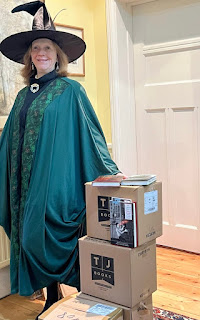Making History by Susan Price
 |
| Norah Lofts |
I'm enjoying the book I'm reading on my kindle.
No surprises there. A complaint I've heard all my life and still hear often (especially from my partner) is that I'm 'always reading,' always 'got my nose in a book.'Although it's hard to put your nose in a kindle. I have found that when you read in bed and doze, the falling Kindle strikes your nose a far more destructive blow than a paper book. Wakes you up. This hasn't stopped me, though. The book I'm reading and thoroughly enjoying at the moment (despite the risk to my nose) is The Town House by Norah Lofts. I've just finished her similar Bless This House.
Bless This House was first published in 1954, before I was born. The Town House, first published in 1959, is the start of a trilogy, being followed by The House at Old Vine (1961) and The House at Sunset (1962).
 | |
| Bless This House by Norah Lofts |
The reader has an understanding that the characters lack. For instance, a girl living in the house during the 19th Century finds that a dreadful, paralysing sense of despair grips her whenever she goes near a window-seat in the Great Hall during daylight. If she enters the room at night, despair becomes terror. She doesn't understand it, but the reader knows who it was in an earlier century who first experienced that despair and left its mark on the house.
The Town House and its sequels take the same idea, of a house and the passing centuries, and extend it. The first book begins in 1391 and follows the building of 'the house at Old Vine,' the people who lived in it and the times they lived in. The final book tells of the house, still standing, in the 1950s which was, when Norah Lofts wrote it, the present day.
Born in 1904, in Norfolk, Norah Lofts came from a farming family - she said that all of her male relatives, for living memory, had been farmers. Her understanding of farming and the seasons, her love of the countryside's beauty are strong elements in her writing.
Each story is told in first-person narration and few of the characters, seen like this from the inside, are especially likeable or have noble motivations. Some are desperate in love, others vengeful, ambitious or selfish. In the next story we might meet them again, years older and seen through the eyes of a character from the next generation. We see how time has changed them and how they are judged by those around them. We, the readers, who know far more about them, may think that judgement too harsh or too kind.
Norah Lofts understood that no matter how hard some people work, no matter how much they hope or love or pray, the indifferent world goes on turning through its seasons and is not influenced by hard work, hope, prayer or love. What happens, happens - and if things turn out well for us, we think that it's our optimism or prayer or effort that made things fall that way. But it was simply luck; and for many other people, just like us, things went badly.
 |
| The Town House by Norah Lofts |
But here I was, reading them on a nose-bruising kindle. When I first read them, let alone when Norah Lofts wrote them, I don't think anything like an e-reader was dreamed of even in Science Fiction. It was a time when people who actually worked in the computer industry predicted that there might be a world market for about twenty computers. This, of course, was when even the most excitingly modern computers were the size of a room and packed with big glass valves.
Now, I carry my little hand-held computer about with me from room to room, as I always used to carry a book - except that the kindle holds a whole bookcase of books. Reading on it has become as ordinary to me as switching on the light or filling my kettle at the tap - ordinary things which are also quite astonishing and trail a long history behind them.
I also publish on the kindle and that, too, has become quite ordinary to me even though I only began five years ago. How quickly miraculous things become mundane. When I began self-publishing, only five years ago, I was working in an university as a Royal Literary Fund Fellow. I remember students becoming excited when they spotted my kindle. "Is that one of those electric reading thingies?" I had to switch it on and show them how it worked. They were agog.
I remember reading my kindle in a pub as I waited for my agent. It was a rather posh pub on the outskirts of Oxford and a retired general type stage-whispered to his wife: "That lady has one of those e-book gadgets." And when I read it in a cafe, the waitress quizzed me about it: Was it easy to get books for it? Was it easy to download them? Only she wanted to encourage her sons to read and she thought they would read an ebook more readily than a paper one.
These days, who would notice an ebook - except perhaps to sneer at it for not being the latest smart phone?
My point? Only this: Time is always moving on through the centuries, just as Norah Lofts describes it moving over and through The Old Vine, first newly built and finally ancient and ruinous. Each generation that lives in it thinks themselves the very last cry in forward thinking and modernity - until the next generation comes along. And we, and we, my electrical friends, just by reading our favourite books on our favourite gadget, by self-publishing, by writing for this blog, we are making history too, in our time, for a while...




Comments